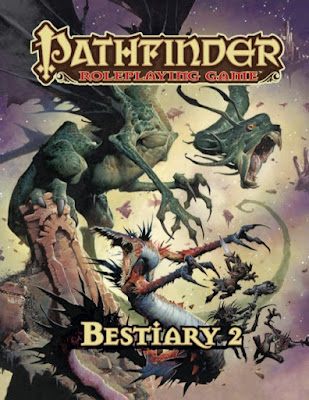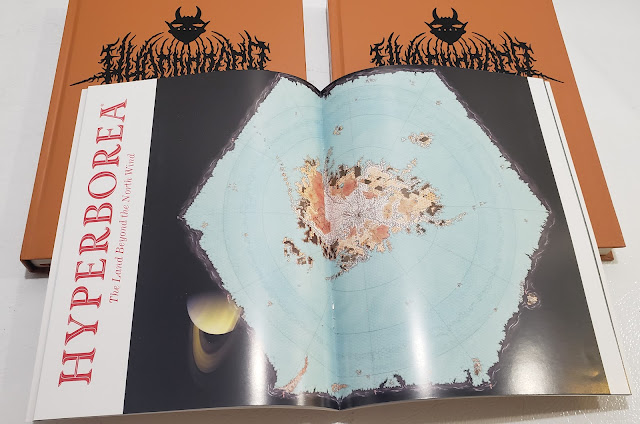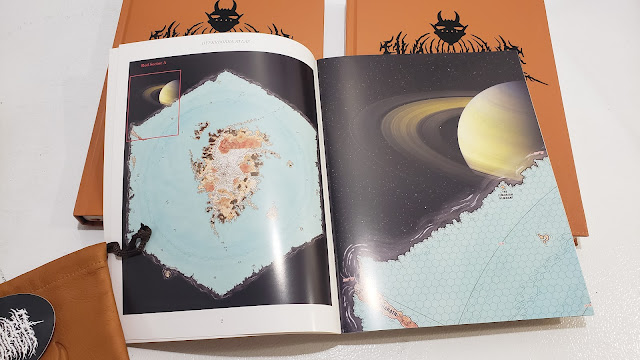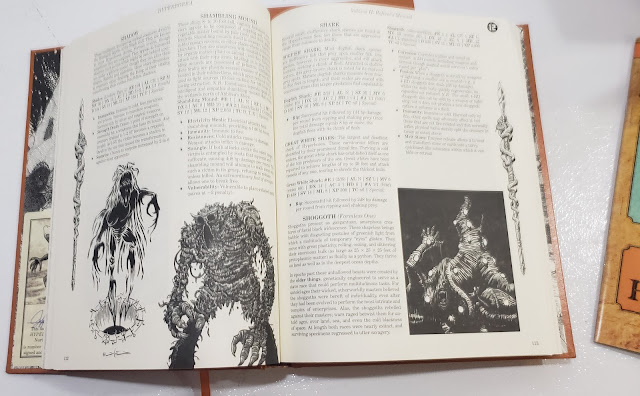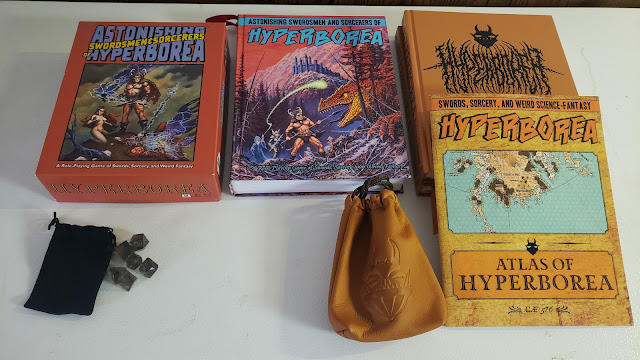Been kinda of obsessed with lists lately. But this one does have a point for me. A while back (2004 in fact) the Pazio run of Dungeon Magazine listed their top 30 adventures of all time.
I have been going through what I call the "Classical Canon" of D&D. Not just so I have the experience of running them all, but so my kids can also enjoy these great adventures. I also am looking for what makes a truly great D&D adventure; something that people still talk about years later.
Anyway here is the list with my thoughts.
30. The Ghost Tower of Inverness, 1980 (C2)
This is great one, but an odd one to run with a party in an ongoing campaign. So I used it in my
Doctor Who Adventures in Time and Space playtest and ran it as "The Ghost Tower of
Inverness, Illinois". I
used this as the location of the "Ghost Tower" which is actually a malfunctioning Time Beacon.
29. The Assassin’s Knot, 1983 (L2)
Personally I prefer
L1, Secret of Bone Hill, but this is a great sequel and I can see why many people like it more than Bone Hill. Assassin's Knot works well as a murder mystery, but not great if your players are wanting to go in a bust skulls.
28. The Lost City, 1982 (B4)
I played this one in 8th Grade when it was new and had a blast. I ran it again for my kids a few years back and still had a blast. There were so many things in it I had forgotten and I spent most of the module smiling to myself in memory. It is a Moldvay classic really and really has the feel of early 80s Basic D&D.
27. The Sinister Secret of Saltmarsh, 1981 (U1)
This was one I played back in the day but I have yet to run. I have it all ready to go with my 3rd Ed. conversion notes. Of course at the time I thought this was great because I was deep into my Anglophilia and I thought ANYTHING from England was perfect. Given that it was written (in part) by Don Turnbull then it was bound to be good. If I remember right I played this one after Lost City. I loved the tenor and mood of the module. It inspired an adventure I wrote in 88 called "Home by the Sea". Parts of that adventure were then later used in my Ghosts of Albion adventure
Blight, which took place in Ireland. So it all came full circle.
26. City of Skulls, 1993 (WGR6)
This is an odd one. I never played it, never ran it and never really heard anything about it. This was near the end of my Ravenloft games and very, very close to the time where I took a huge break from D&D. I will check it out sometime, but doubt if I'll ever run it.
25. Dragons of Despair, 1984 (DL1)
I never played or ran any of the Dragonlance modules. I enjoyed the books when they came out and I liked the idea that everyone playing was going through it all at the same time. Hey, maybe someone should revive this for the next D&D Encounters! I loved the idea and I loved the new design of the modules, but even then it felt a little railroady to me. Plus I wanted to use my own characters.
24. City of the Spider Queen, 2002
I am not a good judge of this one. I don't like Drizzt. I don't like R.A. Salvatore. I never really cared for the Forgotten Realms till about 4th Edition. I don't really know anything about this module. I suspect it was added to the list because there was a dearth of "modern" adventures and most of the others were "Greyhawk" related.
23. The Forgotten Temple of Tharzidun, 1982 (WG4)
Now this adventure...This one I can get behind. I never played this one, but I have run it twice. It's a death dealer and a peak into what might have been coming as a narrative arc if Gygax had been into such things. This module is one of out first peeks into the horror that is Tharzidun, a god that is part Cthulhu and part Satan in my game. I am weaving material from this module into my larger campaign.
22. The Lost Caverns of Tsojcanth, 1982 (S4)
The same is true for this module. I remember buying it as soon as it came out and I begged my DM to run me through it. I have run it myself twice since, the most recent time with my
Dragonslayers group. This is one of my most favorite modules. It has a vampire, Iggwilv, tons of new demons (many that later became part of the
Monster Manual II) and just enough puzzles to keep the players on their toes. Running it
this last time was a lot of fun.
21. Dark Tower, 1979 from Judge’s Guild (JG 0088)
While I would argue that this is an obligatory JG entry, this one is actually a lot of fun. I never played it myself and it is so rare on eBay that it has been cost prohibative. Thankfully we have PDFs of the
Original and of the
3.5 update.
20. Scourge of the Slave Lords, 1986 (A1-4)
Another classic getting the reprint treatment. I remember playing this one in 8th grade as well. My DM at the time folded the Lost City into the A series to make a campaign out of them. Also he had a copy of Grimtooth's Traps which made everything deadlier. Or as he said "better". I still have a thief stuck somewhere in a pit trap.
19. Against the Cult of the Reptile God, 1982 (N1)
I have never played or run this one. I have though always wanted to use it as a start of a "Second" campaign, After running the Classical Canon, I would start with a new campaign focusing on reptiles as the enemy. Work in some modern "Reptoids" and have a go at it. Maybe someday I will still do this. But this is a fun adventure to read.
18. The Hidden Shrine of Tamochan, 1980 (C1)
Another great old module I never played, but read many times. Like N1 I always hoped that I could use this one as part of a second campaign. Though given some of the elements I would not be amiss using it in my "Come Endless Darkness" campaign. I already have too many modules/adventures for the 5-7 level range.
17. Ruins of Undermountain, 1991
Ah. This is one that I have always known about but never really bothered with. It was Forgotten Realms so I never gave it much thought. Though I always thought this was more of a campaign expansion, ie part of the the whole Underdark deal so I never considered it an adventure.
16. Isle of Dread, 1980 (X1)
Oh the hours I spent pouring over this map. This was Tom Moldvay's love letter to the pulp era and to such classic horror movies as King Kong. This also included the first full map of the Known World. I ran it many times as a kid and it was one of the first modules I ran for my son. He wanted to go an island of monsters, "like in Godzilla". This did not disappoint him or me. More so than any other adventure, the Dragonslayers were born here.
15. Castle Amber, 1981 (X2)
Another great. Again Moldvay's pulp horror influences are showing here, in particular his love for the works of Clark Ashton Smith. This time we enter an old house full of crazy characters and plenty of dangers. This could have come off as a "fun house" dungeon, but something in the presentation is different. Maybe it is the undertones of horror and dread. My players in our 5e game are going through this one now. I have dropped the first hints of the "coming darkness" to them here.
This is one of my personal favorites. Certainly part of my top 5.
14. Dead Gods, 1997
Dead Gods is not an adventure I have ever run or been in, but it is one I have used quite a bit. There are a number of elements in it that I use for my "Rise of Orcus" plot. Especially back in the 4e days and the rise of Orcus adventures. Honestly there are enough adventures out there that you could build a universe (and edition) spanning mega campaign on nothing more than stopping the machinations of Orcus. One day I should give that a try.
13. Dwellers of the Forbidden City, 1981 (I1)
This is a great adventure and part of my "Second Campaign" (AGGHHH too many adventures to play!) it is also at the 4th-7th level sweet spot. This one is a key part of that idea since it introduced the Yuan-ti, a monster I have used repeatedly; often calling them Ophidians. It has elements that would fit in nicely with my 5th edition group, but I have too many adventures for this level.
12. The Forge of Fury, 2000
So this is our obligatory 3e adventure I think. I never played it or ran it, thought I have read it. Personally I think
The Sunless Citadel was better and should have been on this list. It was the first and introduced a generation to Meepo. Sure he was no Aleena, but you could also say that Aleena was no Meepo!
11. The Gates of Firestorm Peak, 1996
Ugh. Sorry, but there is a lot about this module I just don't like. I don't care for the shoehorn plot for starters and I hated the Skills & Powers books. Som much that it threw me off of D&D till 3e came out. It was "Lovecraftian" and I did like that. I suspect that is why it is on this list to be honest. Though many of the ideas in this module came into sharper focus during the 3e years.
10. Return to the Tomb of Horrors, 1998
You have to admit. This is a total cheat. I have it, I enjoyed it and I like the idea that the Tomb is something that people can keep going back too (whatever the edition). As a sequel there is a lot to like. As a stand alone and on it's own merits though it might be passable.
9. White Plume Mountain, 1979 (S2)
I am inordinately fond of the S series of modules. This one is no different. It of course makes 0 sense, but works great as an epic D&D adventure. Plus it gave us Wave, Whelm and Blackrazor.
8. Return to the Temple of Elemental Evil, 2001
In many ways I like this one
better than the original. I like the idea of returning to the Temple I also like the idea of talking in game about adventures that came before. Gives me a sense of continuity. This is one of my favorite 3.x era modules to be honest.
7. The Keep on the Borderlands, 1979 (B1)
What can I honestly say about this one? The Cave of Chaos were as well traveled as a local Mall in the 1980s. When I think "Classic Canon" this is the first thing that comes to mind.
6. The Desert of Desolation, 1987 (I3-5)
Another total cheat this "super" module is made up of
Pharoah (I3),
Oasis of the White Palm (I4) and
Lost Tomb of Martek (I5). Though to be totally fair they are linked together. Another really great set of adventures I would LOVE to play or run (read them many times) but not likely to. Maybe if I do my "Second Campaign". There is a lot in these I have used elsewhere though.
5. Expedition to the Barrier Peaks, 1980 (S3)
"You know what AD&D needs? Freaking laser guns! Lasers and killer robots!" Seriously. Has there ever been a module to encapsulate everything the late 70s and early 80s was all about more than this one? It even has a karate instructor robot. I am going to add in a break-dancing robot that moves to a funky Herbie Hancock beat when I run this next. Which should be soon. I am going totally gonzo with it too. I am grabbing bits of Gamma World and
Metamorphosis Alpha too. In fact since the characters are higher level than the module requires I am doing a sort of "Return to the Barrier Peaks" spin on it. I am going to add some material from
The Illithiad as well.
4. The Temple of Elemental Evil, 1985 (T1-4)
Another of the classic canon. If you didn't start your adventure in the keep, then chances are you started it here. I have always wanted to run this one and never have. I have used pieces of it before.
I suppose if I do my "second campaign" I will start with this and change the temple a bit.
3. Tomb of Horrors, 1978 (S1)
We just finished this one and it was every bit the meat grinder it was rumored to be. I had gone through back in the day, but running it was a completely different experience. Now I might be branded as a heretic here but it is not really that good of an adventure. Really it isn't. There are lot things in the adventure that don't make sense except in a D&D world. That being said it is a rite of passage and everyone should try it at least once under their favorite edition or at least once under 1st ed as Gary intended it to be.
2. Ravenloft, 1983 (I6)
Here we go. This is my favorite module on the list. I just love it; warts and all. Yeah there are some real leaps in logic in this one and there are plenty of reasons NOT to like it, but I don't care. I think it is great. It's a Hammer Horror film in D&D form right down to the small "Hammer Hamlet" village with terrified peasants. There are vampires, gypsies, werewolves, really strong zombies, gargoyles. Even a huge pipe organ played by the vampire. You can almost hear
Toccata and Fugue in D minor while running it. I have played through this once and I have ran it three or four times. I would love to try it sometime under the Ghosts of Albion rules. I am going to take my 5e group through it when they complete Castle Amber.
1. Queen of Spiders, 1986 (G1-3, D1-3, Q1)
The first AD&D campaign arc. We talk alot about being "plot free" in our adventures but when it get right down to it we love a good story arc and the GDQ was that. I am not 100% sure that Q1 lived up the promise of the G and D series, but damn was it fun.
This super module was made up of:
Back in the day EVERYONE was going through this. It was the D&D Encounters of it's time. The only problem was no one was doing it at exactly the same time or way. So I know dozens of stories about how these turned out. I have dozens of my own. Plus that Bill Willingham cover of the Giants is one of the most iconic covers of the age I think.
There you are. The 30 greatest adventures as ranked by Dungeon Magazine.
Do you agree or disagree? What is missing?
Here are my honorable mentions.
In Search of the Unknown, 1978 (B1)
Every adventure starts somewhere. Mine usually start here. This is my go to module for a quick a easy sandbox style dungeon crawl. I have run it half a dozen times or more with new groups and it is always a thrill.
Palace of the Silver Princess, 1981 (B3)
Yes it is a rather silly adventure, but I really enjoy it. Plus the backstory on it makes it a lot more fun.
Palace of the Vampire Queen, 1976 from WeeWarriors (V2)
The first ever published adventure or "DM's Kit" as it was called then. What it lacks detail it makes up for in style. I have ran this one twice now under various systems. It works with everything to be honest; it is that sandboxy.

